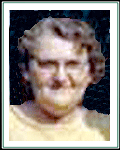
At about this time of year,
Dad would
look out the window at the deep snow banks and say to
Mother, “Well it looks to me like the cold weather has
settled in. Do you think we should butcher those hogs
tomorrow?”
Of course, it was a rhetorical question
since Uncle Ralph and
Aunt Addie had stopped by earlier in
the day and both ladies knew that butchering was the topic
of conversation between the two men. It was a matter of
importance to have enough help to know how many hogs were to
be killed, who needed help next week and other small
details. No matter if the ladies wanted to be putting up
meat tomorrow, it was when the men could do the job that
counted!
Mother always was ready. It just meant
putting away her quilt pieces or her carpet rags. That was
her winter work, just as canning, gardens, little chicks and
cooking for hired help or thrashers was summer work. Every
minute was full, winter or summer, so what difference did it
make what the work was? Butchering meant a welcome change of
diet, instead of chicken, eggs, mush, bean soup, and other
in between foods.
Dad and Uncle Ralph always worked
together, since they only lived about a mile apart.
Butchering was done at our house. We had better facilities
like a big barn to get in out of the weather. It had to be
cold so the meat would cool quickly. We needed a barn to
hang it high away from any wandering dogs who might be
tempted during the night. It was always done early in the
week, too, for caring for all the pork so it wouldn’t spoil
took a lot of time.
Dinner was always liver and buckwheat
pancakes which my mother was a past master at making. I
suppose today they would be called “sourdough” pancakes. I
never minded missing dinner that day, though, for I do not
like liver but in those days you did not argue. If it was
good for you, you ate it!
Supper was a different meal. We always
had tenderloin, mashed potatoes, brown gravy, hot biscuits,
pie and whatever vegetable was handy. Tenderloin is the meat
from the pork chops without any of the bone. Dad just peeled
it along the backbone in a long piece, and then cut it in
thin slices. Mother fried it in her old iron skillet and it
came to the table brown and delicious.
Butchering was hard work for both men
and women. It was a job that took all available hands to
finish. After the halves had cooled overnight, it was time
to make sausage, lard, head cheese, scrapple, liver sausage,
pickled pig’s feet and tongue and to put the sides down in
brine to cure into bacon. Hams were also brined so they
could be smoked. Uncle Ralph did that chore since he had a
smokehouse.
Leaf lard was made from the long slabs
of fat just inside the hog’s belly. It was very white and
did not have to be ground up. It just melted in the pan set
on the back of the old Monarch cook stove, done slowly so it
would not get over hot. This lard made fine cakes and
cookies. It had almost no taste but a texture like modern
Crisco. The rest of the fat, trimmed off the carcass, was
ground in the big grinder (by hand power) and “fried out”
closer to the front of the stove. It too was not allowed to
over heat but did not melt as readily as the leaf lard. It
had to be heated until all the grease was extracted and all
the water was gone. This lard was used for pies and for all
frying of which we did a lot. Most meats were fried when I
was a child and fried potatoes were on the supper table
every night. Lard was the only shortening we had.
The sausage was also ground by hand. We
did not put ours in casings. Instead, Mother made it into
patties which she fried until done and “put down” in a
crock, filling the whole thing with lard to make it keep.
That way, we enjoyed pancakes and sausage for a long time.
Steaks were treated the same way.
It took the better part of a week to
get it all done and was a lot of work but it was the only
way to do it. There were not modern pressure cookers to can
with or freezers to store it in.
For Christmas, as long as he farmed,
Dad gave us half a hog and it was a most welcome gift.
Florence
Toburen, Onondaga

